The Narendra Modi-led National Democratic Alliance, armed with its electoral catchphrase, “Jungle Raj ka Yuvraj”, hit the opposition led by Tejashwi Yadav where it hurts the most. The Bihar election results hint that the narratives of the ‘Jungle Raj’ succeeded in forcing people to recall the politics and governance that ended 15 years ago and which, according to the detractors, carried crime in its DNA. The NDA’s poll strategies may have ensured Nitish Kumar’s return by evoking the ghost of the Jungle Raj, but crime data tells a different story.
A simple analysis of the National Crime Records Bureau’s (NCRB) annual data on cognisable IPC crimes in major Hindi-belt states shows that, in the last 45 years, crime count was lowest in Bihar.
But since the 1990s, Bihar has been reduced to dark narratives and pejoratives such as BIMARU and Jungle Raj – the second one being the most damaging for the state’s development.
Bihar’s journey to Jungle Raj
The entire Jungle Raj narrative emanates from imaginations of poor law and order situation and high crime rates in the 1990s. The narrative, largely built and reinvented around sensational crime stories with graphic details in media, stocks of anecdotes, and electoral political narratives, turned Bihar into a dreaded place in people’s imaginations. It made such a deep impact on the psyche that even Biharis living in other states would avoid visiting their hometowns or villages, forget about outsiders.
The narrative, however, is rejected by scholars such as Christophe Jaffrelot who refers to the period as a regime of social justice. It is said that with the advent of Lalu Prasad Yadav’s government in Bihar, the established political power hierarchies (well aligned with caste hierarchies) faced stiff challenges. The oppressed castes and minorities found a voice and raised it to a level uncomforting to certain sections of society holding key positions in each of the four pillars of democracy.
While as chief minister, Lalu Prasad, and a few of his kin and close aides, were found to be involved in crimes of varying degrees of intensity, it was, however, used as a peg to hang the entire government and administration. The Jungle Raj narrative, which had started around the criminal acts of ruling politicians, was solidified with the incrimination of Lalu Prasad in corruption cases. While the incidence of any crime is unjustifiable, it seems that the issue of crime in Bihar has been magnified with the lens of the Jungle Raj narrative. Lalu Prasad Yadav and the Rashtriya Janata Dal (RJD) governments were held disproportionately more accountable for the same issues than any other ruling government in other states.
Also read: Tejashwi’s arrival, Nitish’s tenacity, Shah’s masterstroke — 5 takeaways from Bihar results
Crimes, facts, and fiction – what data tells
The NCRB data on cognisable IPC crimes for the last 45 years shows that crime counts (both in terms of absolute figures and in proportion to the population, as seen in Figures 1 and 2) was the lowest in Bihar among all Hindi-belt states. The analyses certainly include RJD’s ‘misrule’ phase, on which the entire Jungle Raj narrative had been premised. Even in comparison to Gujarat (taken as ideal in terms of investment climate, post-reform economic growth, and development), Bihar performed better and consistently registered lower crime counts.
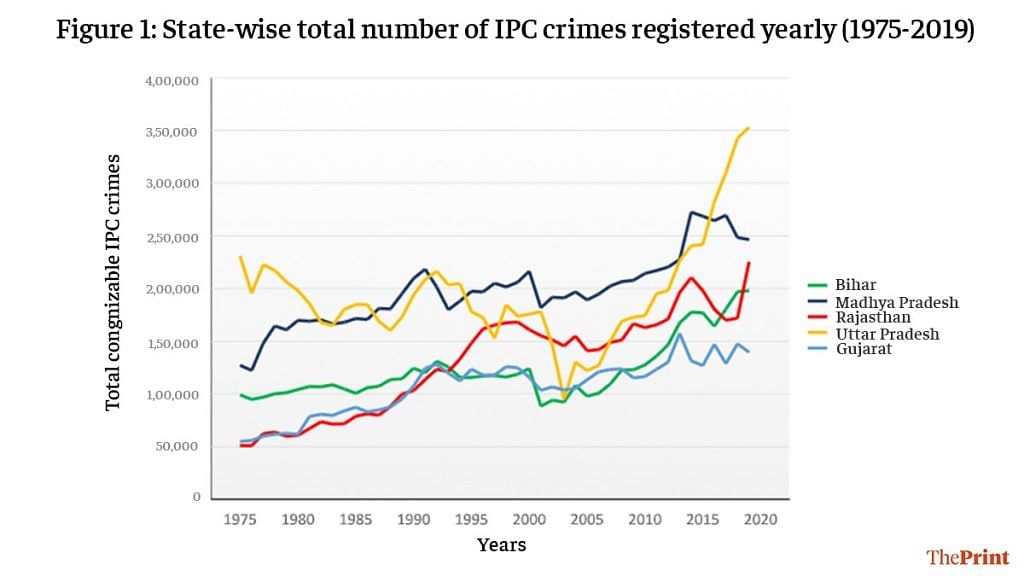
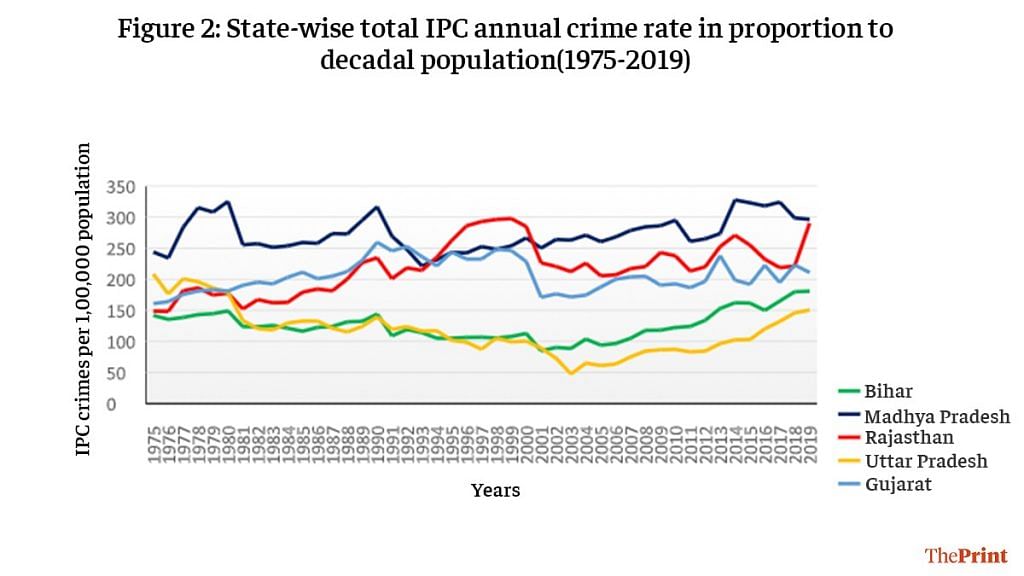
Bihar’s position in interstate crime statistics is counterintuitive and does not add up to the Jungle Raj stories. It, nevertheless, does not absolve the RJD from the popular opinion that it was the worst in terms of law and order and witnessed huge spikes in crime with every passing year.
A close look at data (crimes per 100,000 population), however, clears the air and gives us a diametrically opposite understanding (Figures 3 and 4). It shows that the phase of so-called misrule and Jungle Raj (1990-95) was, in fact, marked with the lowest crime rates in the last 45 years in Bihar. Moreover, a significant dip in crimes can be seen during the RJD’s rule in comparison to the preceding 15 years, whereas a sharp consistent rise in the same is seen with the arrival of the Janata Dal (United) or JD(U).
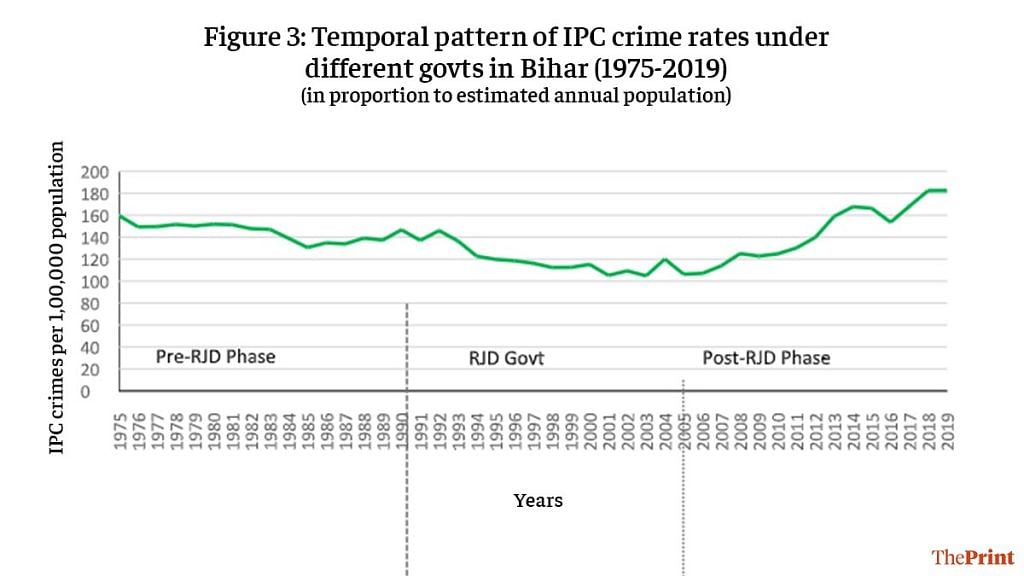
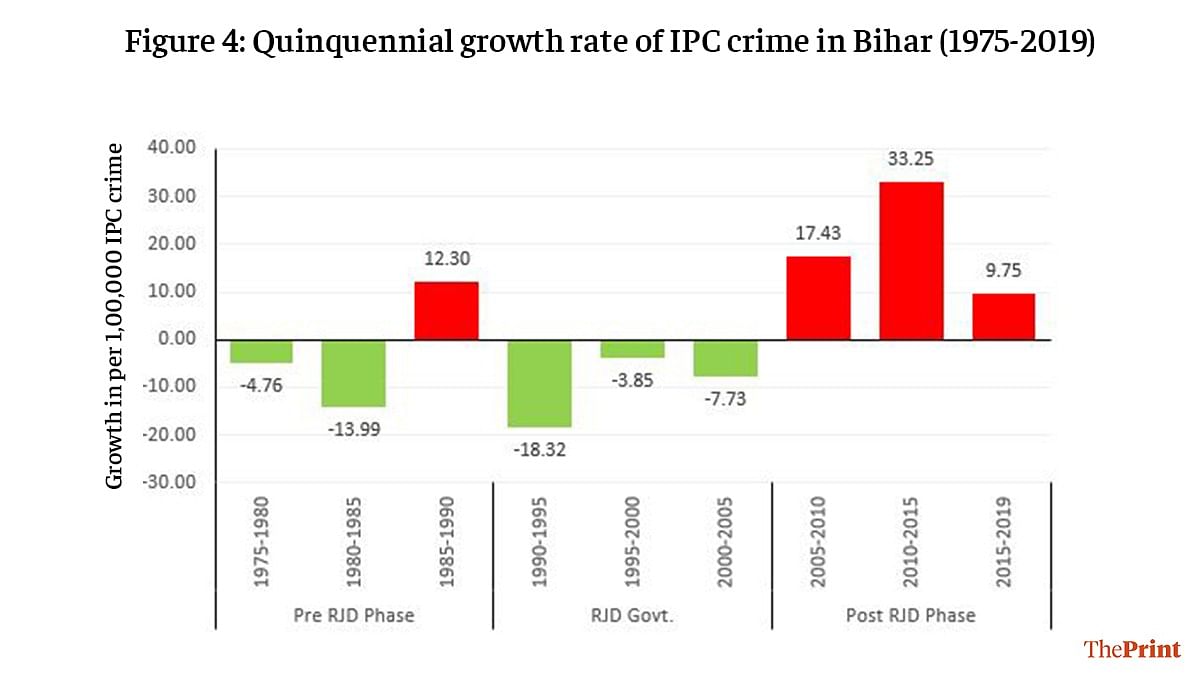
The biggest irony is that the quinquennial crime growth rate – that is, the rate every five years – registered a fall of -18.32 per cent in the first term of Lalu Prasad (a perceived culprit in Bihar’s history) as against a rise of 17.34 per cent during the first term of Nitish Kumar (known for sushasan and development), which further went up to 33.25 per cent in his second term.
Also read: Modi brings up ‘Jungle Raj’ as BJP and JD(U) fall back on old line of attack on RJD
Economic impacts of the Jungle Raj story
The contradictions between data and Jungle Raj narratives are stark and seem to have served their political purpose well. However, they have been remarkably damaging for Bihar and its people.
While the JD(U)-led governments failed to make any significant change, Nitish Kumar could also barely dispel the spectres of the Jungle Raj. This along with other structural variables in effect kept innovators, investors, industrialists, and capital away from the state and subdued Nitish Kumar’s development agenda. A review of the FDI (foreign direct investment) inflows in Bihar gives important insights on the issue (Figure 5). While FDIs depend on a host of factors, they are very sensitive to the prevalent socio-political environment at investment locations. Bihar received only a paltry amount as FDI when other Hindi-belt states (even with higher crime rates) kept receiving investments in varying amounts in the post-reform period.
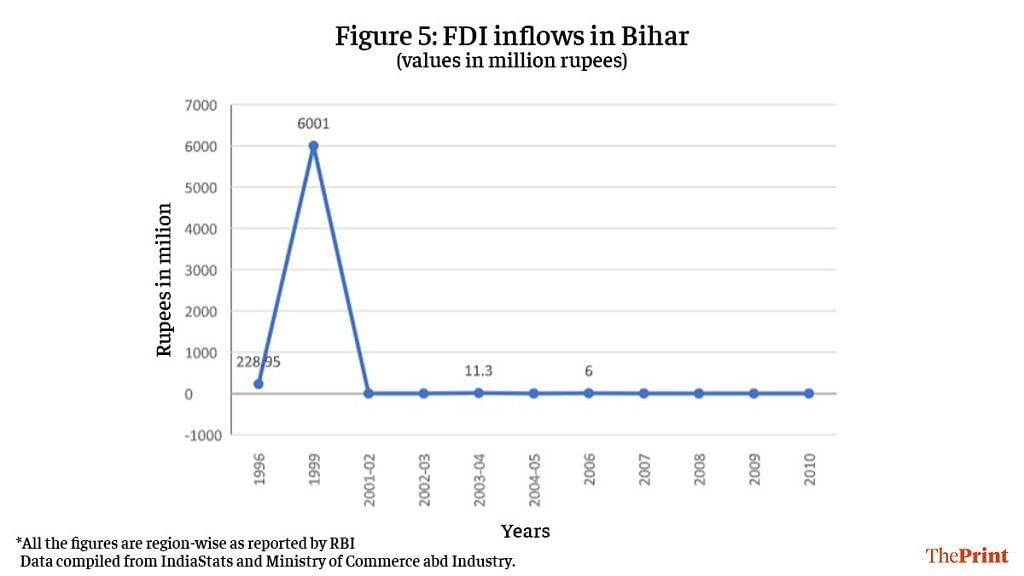
In a transforming post-reform Indian economy, the market forces were expected to play a significant role in economic growth and generation of employment and other positive externalities. Bihar, however, overcast by the Jungle Raj story, failed to exude any positive vibes for market forces and therefore missed out on opportunities. It failed to attract investments, witnessed dismal levels of job creation, per capita production, and income. This led to economic inertia and caused a significant increase in the rate of out-migration from Bihar (Figure 6).
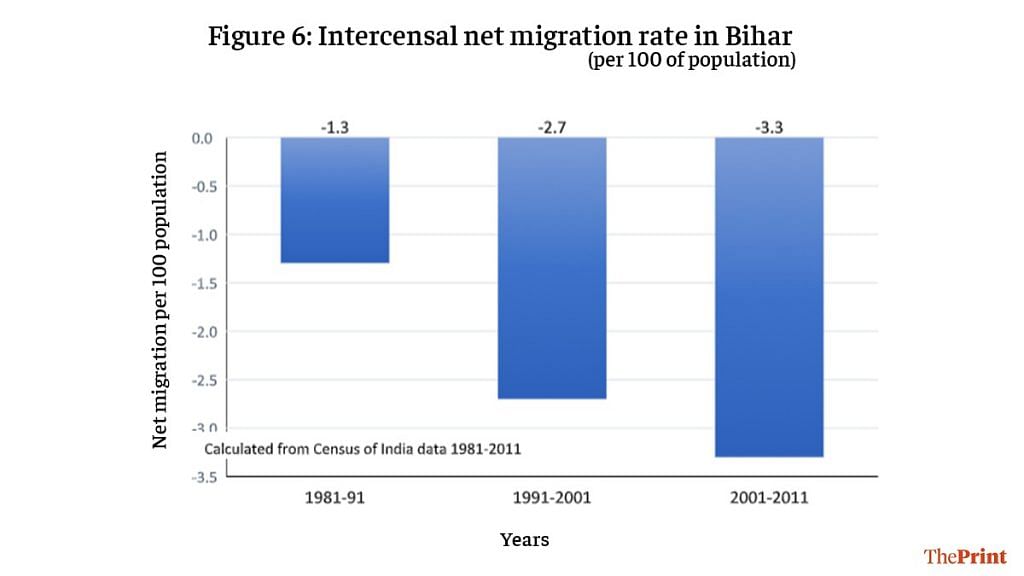
In a period of two decades (1991-2011), Bihar’s net-migration rate has doubled. In only the last decade, more than 30 lakh people migrated from Bihar, which consisted primarily of the young population, also known as ‘demographic dividend’ in development debates.
In the post-reform period, when many states were making development strides, Bihar largely remained in a unique fix. Its complex political metamorphosis in the ’90s trapped it into something called ‘simultaneity’ in statistics (wherein X causes Y, and Y in return causes X, and so on). The narratives manufactured to replace the RJD-led ‘social transformation regime’ with a ‘pro-development political regime’ did irreparable damages to the image of the state. They turned Bihar into a no-no for market forces and development agents. And the JD(U), after its failures on sushasan and development agenda, kept refreshing and reinstating the Jungle Raj narrative for electoral gains. So, any positive sentiment and interest towards the state, germinating on the time-healed public memory, were diffused and Bihar remained stuck in the unique fix between Jungle Raj and underdevelopment.
Also read: Despite the sweet victory, Modi-Shah BJP has a Nitish Kumar-sized problem in Bihar
Time to get over Jungle Raj
For long, we have been witnessing Bihar and its people stuck under imposed identities. While the people seem desperate to shake off manufactured narratives from the past and make a fresh start, a large section of the state’s political leadership keeps harping on the past. However, as seen in the 2020 election campaigns, people want to hear about their real concerns – education, health, unemployment, development, and migration. So, this may be the best time to mainstream people’s questions in political narratives. If Bihar succeeds, it could be the beginning of a paradigm shift.
The author is Assistant Professor, Centre for Health Policy, Planning and Management, Tata Institute of Social Science. Views are personal.


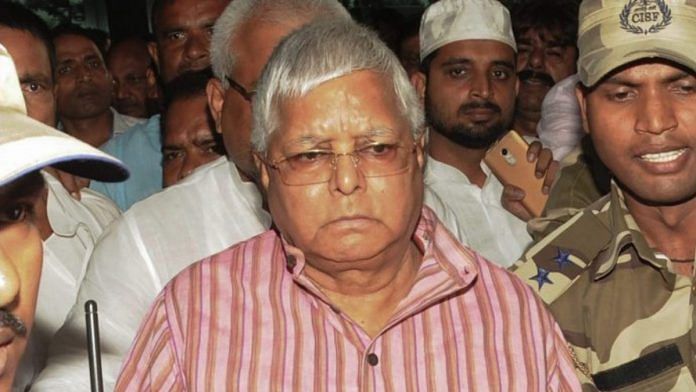

What a giant boatload of crap. People like me have lived through those times and the author is trying to convince me its was all “perception” sitting in delhi by talking to some professor !!! I will give you few examples and i am sure plenty of people will have similar experiences.
1> My family (dad/mom and myself) got off a train at Shiekhpura Jn on KG line of indian railways at 4 pm in evening. our village is a short 8 km drive from there. There was no public transport willing to venture out after dark. After 30 mins only people out were ones with guns sticking out of their cars. So, we spend the night at railway station and went to village next day.
2> Patna city 7pm at pan shop. just me and my best friend out to grab a smoke because we have escort. His father is SP and we are in his dad’s Gypsey with red beacon.
3> Darbhanga city: 7pm evening. entire city is dark with no power. the main city road is dirt track with no trace of asphalt. All you hear is “phat phat” of generators and shall shopkeepers with kerosene lamps.
This was the reality of the time. I don’t need the author to tell me if “jungle raj” was real or now. People who have lived through the times remember it vividly. But for the Leftist gang everything is justified in the name of “social justice” and “revolution”.
This is a worst example of sold out journalism. This article narrates so called data on crime when the very question is what is the reliability and validity of this data. In jungle Raj when police was working for Lalu and His gang then who would have registered the cases and the data? This is nothing but an eyewash to defend the Jungle Raj. Shame on your journalism.
Why not educate the readers with names like :
CHAMPA BISWAS
TRY GOOGLING IT .
Public memory is short. It’s shocking that despite the ‘Jungle Raj’, Laloo’s goons came close to winning! They must thank Rakesh Chandra and his ilk for white washing the bloody rule of Laloo. Data mining from NCRB is a cruel joke. Erase the FIRs , and the country will become crimefree!
Mr Shekhar Gupta, I am a big fan of yours, but another article or two of such poor calibre, and I’ll be forced to review even your ‘unhyphenated’ brand of cutting through the clutter
Statistics and lies! Lallu was projected as the best Railway Minister, gave lectures in Ivy League colleges in USA and much later, the real truth emerged! Now when this guy is in Jail for corruption, we get to read that crime was the lowest in the history of Bihar during Lallu regime! What next? This author may write, economic growth was the highest in Lallu time and cows & buffaloes were yielding maximum milk without fodder. Actually, Lallu was on to something very big – how to get maximum milk without feeding fodder to animals. The CBI mistook and jailed him. Ha ha. Keep writing such fantasy articles so that we can have some laughter in these gloomy times.
The data quoted is official data….and who was in office during the Jungle raaj – Lalu Yadav….It was his rule, with cops refusing to register cases…..with most cases unregistered, the official data would OBVIOUSLY show low crime rate…..and if that was the TRUTH, WHY DID PEOPLE OF BIHAR VOTE OUT RJD GOVERNMENT DECISIVELY in 2005 and 2010…..The author should have ideally spent some time in Bihar….the days of armchair journalism are over.
Absolutely… UP shows huge surge in crimes now because they are getting registered now
–>
While as chief minister, Lalu Prasad, and a few of his kin and close aides, were found to be involved in crimes of varying degrees of intensity, it was, however, used as a peg to hang the entire government and administration.
–>
What !!!
Did you read this again before posting ?
What a display of utter waste data misrepreaentation….lack of data is only reason for Lalu era apperaing beautiful on paper….The print and the writer are hurting the feelings of every person feom bihar whose life was under every day threat under politically nurtured gunda raj. Shame on the writer and big thumbs down for The Print foe publishing such baseles mindless meaningless report by some data mining fool far away from reality.